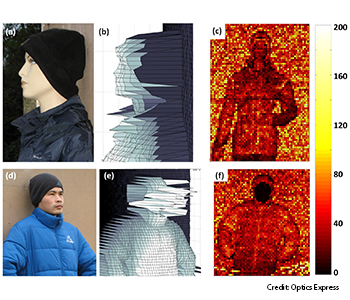
3-D images of two of the authors taken in daylight from 910 meters away. The photograph shows a close-up view of what the scanner sees. The middle left panels show 3-D images with slightly more depth detail than the right-hand panels; this is because the detector spent more time collecting the returning photons for the images on the left than on the right.
A near-infrared laser and the latest in single-photon detection technology have allowed a Scotland-based team of researchers to build a three-dimensional imaging system that works at kilometer-scale distances (Opt. Express 21, 8904).
To add a third dimension to 2-D imaging, the idea of using time-of-flight—measuring the distance from a transceiver to a remote object by sending out a pulse of light, bouncing the pulse off the object and recording the duration of the round trip—is not new. Previous systems, however, have been effective only at much shorter distances because they were limited to wavelengths shorter than 1,000 nm.
For their time-of-flight system, Aongus McCarthy and his colleagues at Heriot-Watt University in Edinburgh used a 1,560-nm pulsed fiber laser with an average power output of 2 mW. That wavelength suffers less from atmospheric attenuation than shorter wavelengths and is relatively safe for human eyes. A superconducting nanowire single-photon detector, operating at 3K thanks to a cryogen-free cooling system, picked up the returning near-infrared signals.
Tests with mannequins and human beings revealed that the imaging system is not particularly good at picking up living faces, thanks to the optical properties of skin in the near-infrared range. However, the device achieved millimeter-level resolution of still objects placed 910 m away in bright daylight.
Two researchers from Delft University of Technology in the Netherlands were also involved in the project.
